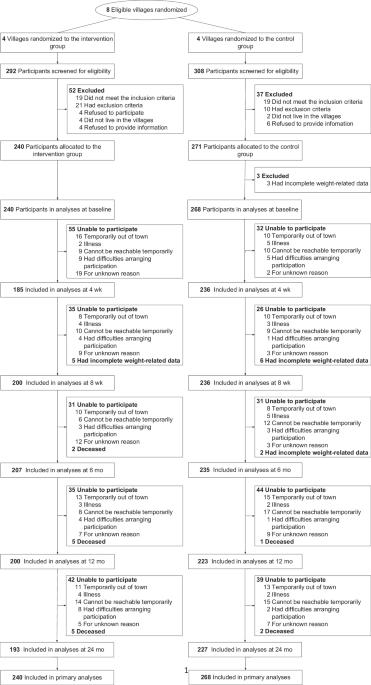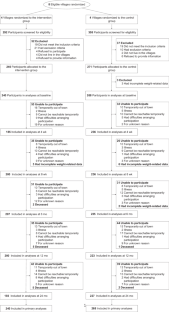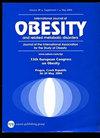体育锻炼干预对中国农村老年人体重变化的影响:分组随机对照试验。
IF 4.2
2区 医学
Q1 ENDOCRINOLOGY & METABOLISM
引用次数: 0
摘要
背景:目前有关体育锻炼干预对成年人体重变化影响的随机试验证据主要来自西方国家,而中国等中低收入国家的可靠证据很少,因为这些国家的生活方式和肥胖模式与西方国家有很大不同。我们利用中国老年人的分组随机试验数据研究了体育锻炼干预对体重变化的影响:分组随机对照试验包括为期 8 周的体育锻炼干预期,并随访 24 个月。八个村被随机分配到干预组(4 个村,n = 240)或对照组(4 个村,n = 268)。干预组接受基于社会生态模式的体育锻炼干预,对照组则不接受干预。干预涉及三个层面:个人层面、人际层面和社区层面,旨在促进参与者的闲暇体育活动。本研究的主要结果是 24 个月后体重变化百分比与基线的差异。我们使用谷田 BC-601 分析秤测量体重,并记录到最接近的 0.1 千克:在 508 名参与者中,平均年龄为 70.93 岁(标准差为 5.69 岁),55.5% 为女性。干预组与对照组的体重变化百分比存在明显差异,平均变化率为-1.78%(95% CI,-2.67%至-0.90%;P 结论:体育锻炼干预可使体重减轻:体育锻炼干预使农村老年人的体重在 24 个月后有所下降。这表明体育锻炼干预对老年人,尤其是超重/肥胖或年龄在 80 岁以下的老年人减轻体重是可行的:该研究已于 2021 年 4 月 20 日在中国临床试验注册中心注册(ChiCTR2100045653),https://www.chictr.org.cn/showproj.html?proj=123704 。本文章由计算机程序翻译,如有差异,请以英文原文为准。


Effect of physical activity intervention on weight change in rural older Chinese: a cluster randomized controlled trial
Current randomized trial evidence for the effects of physical activity intervention on weight change in adults was mainly from western countries, with little reliable evidence from low- and middle-income countries, such as China, where lifestyle factors and obesity patterns differ substantially from those in western countries. We examined the effects of physical activity intervention on weight change using cluster randomized trial data among Chinese older adults. The cluster randomized controlled trial included an 8-week physical activity intervention period and was followed up to 24 months. Eight villages were randomly assigned to the intervention group (4 villages, n = 240) or the control group (4 villages, n = 268). The intervention group received physical activity intervention based on the socio-ecological model, while the control group did not. The intervention involved three levels: individual, interpersonal, and community levels, which aimed to promote leisure-time physical activity of participants. The primary outcome of the present study was the difference in percentage weight change at 24 months from baseline. We used Tanita BC-601 analyzer scales to measure weight and recorded it to the nearest 0.1 kg. Among the 508 participants, the mean age was 70.93 (SD, 5.69) years, and 55.5% were female. There were significant differences in percentage weight change between the intervention group and the control group with a mean change of −1.78% (95% CI, −2.67% to −0.90%; p < 0.001) in the total sample, −1.94% (95% CI, −3.14% to −0.73%; p = 0.002) in participants with overweight/obesity, and −1.45% (95% CI, −2.73% to −0.18%; p = 0.027) among participants with underweight/healthy weight in favor of the intervention group at 24 months. Physical activity intervention resulted in weight loss in rural older sample at 24 months. This suggested that physical activity interventions are feasible for weight loss among older adults, especially for those with overweight/obesity or aged under 80. The study has been registered on the Chinese Clinical Trial Registry on April 20, 2021 (ChiCTR2100045653), https://www.chictr.org.cn/showproj.html?proj=123704 .
求助全文
通过发布文献求助,成功后即可免费获取论文全文。
去求助
来源期刊

International Journal of Obesity
医学-内分泌学与代谢
CiteScore
10.00
自引率
2.00%
发文量
221
审稿时长
3 months
期刊介绍:
The International Journal of Obesity is a multi-disciplinary forum for research describing basic, clinical and applied studies in biochemistry, physiology, genetics and nutrition, molecular, metabolic, psychological and epidemiological aspects of obesity and related disorders.
We publish a range of content types including original research articles, technical reports, reviews, correspondence and brief communications that elaborate on significant advances in the field and cover topical issues.
 求助内容:
求助内容: 应助结果提醒方式:
应助结果提醒方式:


